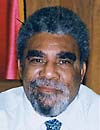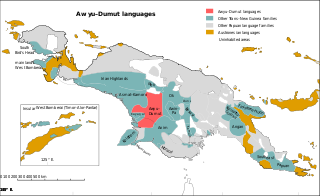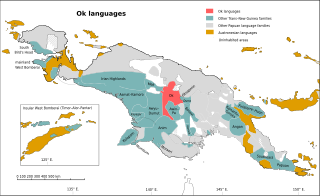Related Research Articles
The Wopkai people, or Wopkaimin, are a small aboriginal tribe of the Faiwol people that lives in the remote Star Mountains in western Papua New Guinea in what is known as the Fly River socio-ecological region. They speak the Wopkai dialect of the Faiwol language.
Indo-Pacific is a hypothetical language macrofamily proposed in 1971 by Joseph Greenberg and now believed to be spurious. It grouped together the Papuan languages of New Guinea and Melanesia with the languages of the Andaman Islands and, tentatively, the languages of Tasmania, both of which are remote from New Guinea. The valid cognates Greenberg found turned out to be reflexes of the less extensive Trans–New Guinea family. Recently the Kusunda language, which is generally seen as a language isolate, is also included in the Indo-Pacific proposal. Greenberg did not include "Australian" in his original 1971 proposal.

Western Province is a coastal province in southwestern Papua New Guinea, bordering the Indonesian provinces of Highland Papua and South Papua. The provincial capital is Daru. The largest town in the province is Tabubil. Other major settlements are Kiunga, Ningerum, Olsobip and Balimo.

Sir Mekere Morauta was a Papua New Guinean politician and economist who served as the 7th Prime Minister of Papua New Guinea from 1999 to 2002. Inheriting a depressed economy and a fractious legislature, he embarked on fundamental reforms of the country's economy and political system.

Mount Hagen is the third largest city in Papua New Guinea, with a population of 46,250. It is the capital of the Western Highlands Province and is located in the large fertile Wahgi Valley in central mainland Papua New Guinea, at an elevation of 1,677 m (5,502 ft).
Tabubil is a town located in the Star Mountains area of the North Fly District of Western Province, Papua New Guinea. The town, including the adjoining relocated village of Wangabin and the industrial area of Laydown, is the largest settlement in the province, although the provincial capital, Daru is a similar size. It had a recorded population of 10,270 at the 2011 census.

The Ok Tedi Mine is an open-pit copper and gold mine in Papua New Guinea located near the headwaters of the Ok Tedi River, in the Star Mountains Rural LLG of the North Fly District of the Western Province of Papua New Guinea.

Oksapmin is a Trans–New Guinea language spoken in Oksapmin Rural LLG, Telefomin District, Sandaun, Papua New Guinea. The two principal dialects are distinct enough to cause some problems with mutual intelligibility.

The Ok Tedi environmental disaster caused severe harm to the environment along 1,000 km (620 mi) of the Ok Tedi River and the Fly River in the Western Province of Papua New Guinea between around 1984 and 2013. The lives of 50,000 people have been disrupted. One of the worst environmental disasters caused by humans, it is a consequence of the discharge of about two billion tons of untreated mining waste into the Ok Tedi from the Ok Tedi Mine, an open pit mine situated in the province.

Mining in Papua New Guinea is an important part of the Papua New Guinea economy.

The North Fly District of the Western Province of Papua New Guinea is the northernmost, smallest, and arguably the most remote of the three districts of the province. It contains the Local-Level Government (LLG) areas of Kiunga Rural, Kiunga Urban, Ningerum Rural, Olsobip Rural and Star Mountains Rural, and the townships of Kiunga, Tabubil, Olsobip and Ningerum.
Boka Kondra is a Papua New Guinea politician. He was a member of the National Parliament of Papua New Guinea from July 2007 until December 2016, representing the electorate of North Fly Open, variously as an independent, for the National Alliance and for the People's National Congress. He was Vice-Minister for Mining (2011-2012) and Minister for Tourism, Arts and Culture (2012-2016) in the O'Neill government. Kondra was dismissed from office in December 2016 after a leadership tribunal found him guilty of misappropriation charges.

The Greater Awyu or Digul River languages, known in earlier classifications with more limited scope as Awyu–Dumut (Awyu–Ndumut), are a family of perhaps a dozen Trans–New Guinea languages spoken in eastern West Papua in the region of the Digul River. Six of the languages are sufficiently attested for a basic description; it is not clear how many of the additional names may be separate languages.

The Kamula–Elevala languages are a small family of the Trans–New Guinea languages spoken in the region of the Elevala River.

The Ok languages are a family of about a dozen related Trans–New Guinea languages spoken in a contiguous area of eastern Irian Jaya and western Papua New Guinea. The most numerous language is Ngalum, with some 20,000 speakers; the best known is probably Telefol.
The Birim River or Ok Birim in the western province of New Guinea is a tributary of the Ok Tedi River, which is in turn a tributary of the north Fly River. The Birim river joins the Ok Tedi river from the west between Ningerum and Bige. The Birim river area is inhabited by the Yonggom tribe. They practise tropical forest Swidden agriculture. About 3,000 people, they speak the Ninggerum language of the Ok group.
Telefol is a language spoken by the Telefol people in Papua New Guinea, notable for possessing a base-27 numeral system.
The Urapmin people are an ethnic group numbering about 375 people in the Telefomin District of the West Sepik Province of Papua New Guinea. One of the Min peoples who inhabit this area, the Urapmin share the common Min practices of hunter-gatherer subsistence, taro cultivation, and formerly, an elaborate secret cult available only to initiated men.
Min peoples or Mountain Ok are a cultural group in the West Sepik Province of Papua New Guinea and Highlands Papua in Indonesia.
Afekan is the a goddess of creation and knowledge in the Tifalmin mythology of Papua New Guinea. Afekan lived with men in the beginning to teach them "how to live in strength and dignity", along with the secrets and rituals of men. She also created taro, pigs, and various cultural things. She has a brother, Umoim, who became the first man to die.
References
- ↑ "Orientation - Telefolmin". everyculture.com. Retrieved 2014-04-05.
- ↑ Jorgensen 1980
- ↑ "History and cultural relations - Telefolmin". everyculture.com. Retrieved 2014-04-05.
- ↑ Golub, Alex (2007). "Ironies of Organization: Landowners, Land Registration, and Papua New Guinea's Mining and Petroleum Industry". Human Organization.
- ↑ Weiner, James; Glaskin, Katie, eds. (2007). Legibility and Recognition in Nenataman. epress.anu.edu.au. doi: 10.22459/CLTRAPNG.06.2007 . ISBN 9781921313264 . Retrieved 2014-04-05.
- ↑ Robbins 2004, p. 15.
- ↑ Robbins 2004, p. 17.
- ↑ Ingold 2000, p. 354.
- ↑ Jorgensen 2002, p. 73
- ↑ Jorgensen 2002; Jorgensen 2006
- ↑ Telefol counting